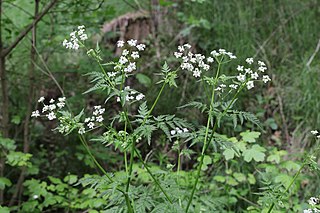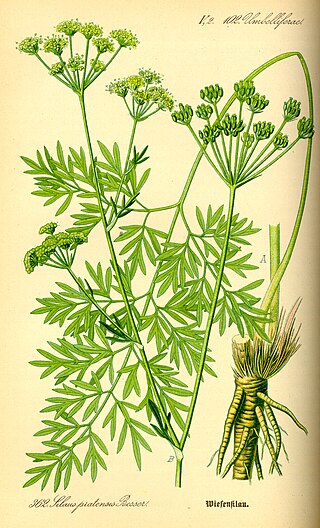
Apiaceae or Umbelliferae is a family of mostly aromatic flowering plants named after the type genus Apium, and commonly known as the celery, carrot or parsley family, or simply as umbellifers. It is the 16th-largest family of flowering plants, with more than 3,800 species in about 446 genera, including such well-known, and economically important plants as ajwain, angelica, anise, asafoetida, caraway, carrot, celery, chervil, coriander, cumin, dill, fennel, lovage, cow parsley, parsley, parsnip and sea holly, as well as silphium, a plant whose exact identity is unclear and may be extinct.

Eryngium is a genus of flowering plants in the family Apiaceae. There are about 250 species. The genus has a cosmopolitan distribution, with centres of diversity in the western Mediterranean, South America and Mexico. Common names include eryngo and sea holly.

Eryngium maritimum, the sea holly or sea eryngo, or sea eryngium, is a perennial species of flowering plant in the family Apiaceae and native to most European coastlines. It resembles a thistle in appearance because of its burr-shaped inflorescences. Despite its common name, it is not a true holly but an umbellifer.

Peucedanum ostruthium or Imperatoria ostruthium, masterwort, is a species of flowering plant in the family Apiaceae. It is native to the mountains of Central and Southern Europe, but has been widely introduced outside its native range.

Smyrnium olusatrum, common name alexanders is an edible flowering plant of the family Apiaceae (Umbelliferae), which grows on waste ground and in hedges around the Mediterranean and Atlantic coastal regions of Europe. It was formerly widely grown as a pot herb, but is now appreciated mostly by foragers.

Peucedanum palustre (milk-parsley) is an almost glabrous biennial plant in the family Apiaceae. It is so called in English because of the thin, foetid, milky latex found in its young parts and is native to most of Europe, extending eastwards to Central Asia. Another English common name for the plant is marsh hog's fennel.

Anthriscus sylvestris, known as cow parsley, wild chervil, wild beaked parsley, Queen Anne's lace or keck, is a herbaceous biennial or short-lived perennial plant in the family Apiaceae (Umbelliferae). It is also sometimes called mother-die, a name that is also applied to the common hawthorn. It is native to Europe, western Asia and northwestern Africa. It is related to other diverse members of Apiaceae, such as parsley, carrot, hemlock and hogweed. It is often confused with Daucus carota, another member of the Apiaceae also known as "Queen Anne's lace" or "wild carrot".

Eryngium planum, the blue eryngo or flat sea holly, is a species of flowering plant in the family Apiaceae, native to the area that includes central and southeastern Europe and central Asia. It is an herbaceous perennial thistle growing to 50 cm (20 in) with branched silvery-blue stems, and numerous small blue conical flowerheads surrounded by spiky bracts in summer.

Epermenia chaerophyllella, also known as the garden lance-wing, is a moth of the family Epermeniidae first described by Johann August Ephraim Goeze in 1783. It is found in all of Europe and Asia Minor.
Parsley or garden parsley most often refers to the widely cultivated culinary herb Petroselinum crispum

Ligusticopsis wallichiana is a species of flowering plant in the family Apiaceae. In cultivation, it has been known by the synonym Selinum wallichianum.

Selinum is a Eurasiatic genus of flowering plants in the parsley family Apiaceae.

Silaum silaus, commonly known as pepper-saxifrage, is a perennial plant in the family Apiaceae (Umbelliferae) found across south-eastern, central, and western Europe, including the British Isles. It grows in damp grasslands on neutral soils.
Milk parsley is a common name for several plants and may refer to:

Tordylium is a genus of flowering plants in the carrot family (Apiaceae). Members of the genus are known as hartworts.

Seseli libanotis, also known by the common names moon carrot, mountain stone-parsley, or säfferot, is a species of herb in the genus Seseli of the carrot family, Apiaceae. It is native to Eurasia, throughout which it is widespread.
Fennel is a species of plant, Foeniculum vulgare.

Oenanthe fistulosa, tubular water-dropwort, is a flowering plant in the carrot family, native to Europe, North Africa and western parts of Asia. It is an uncommon plant of wetlands, growing around pools and along ditches, mainly in areas of high conservation value.

Sison amomum is one of several species of plant in the genus of Sison, its common name is stone parsley and it is native to Western and Southern Europe, North Africa and Turkey. The species and genus are flowering plants in the family Apiaceae, both of which were first described by Carl Linnaeus, in his book Species Plantarum, originally published in 1753. The plant has many synonyms, having also subsequently been described by other botanists, after Linnaeus, including Jean-Baptiste Lamarck, Richard Anthony Salisbury, Conrad Moench, Emanuel Mendes da Costa, and Albert Thellung among others.
















